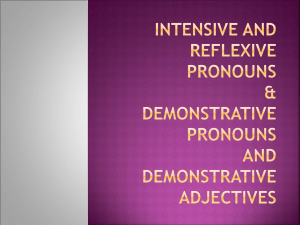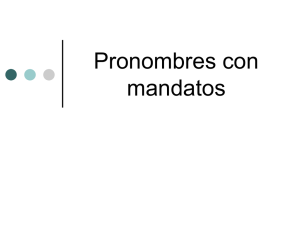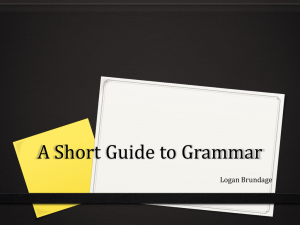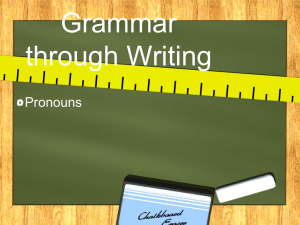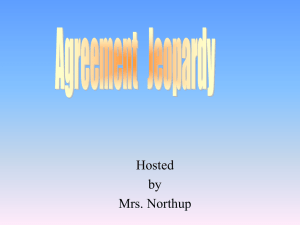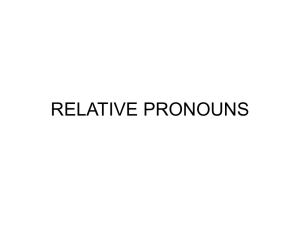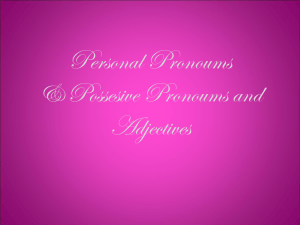I CAN use relative pronouns correctly.
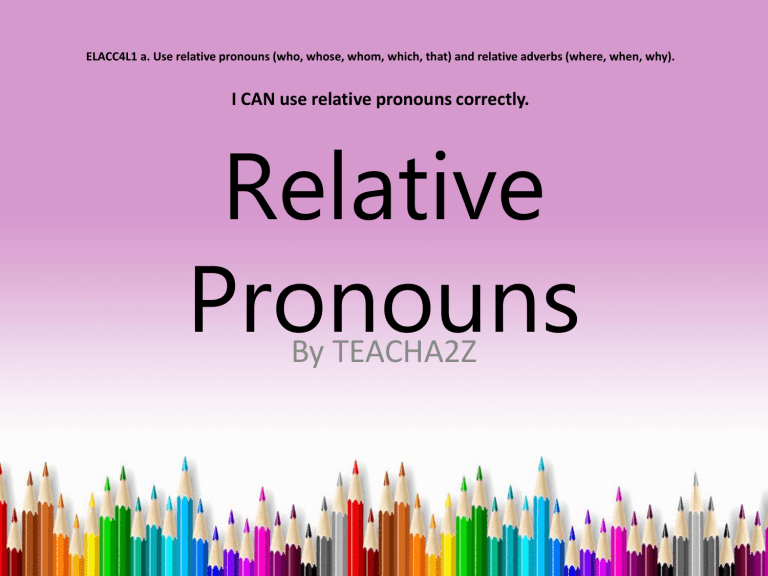
ELACC4L1 a. Use relative pronouns (who, whose, whom, which, that) and relative adverbs (where, when, why).
I CAN use relative pronouns correctly.
Relative
Pronouns
By TEACHA2Z
ELACC4L1 a. Use relative pronouns (who, whose, whom, which, that) and relative adverbs (where, when, why).
Relative
Pronouns
Lesson 1
ELACC4L1 a. Use relative pronouns (who, whose, whom, which, that) and relative adverbs (where, when, why).
I CAN use relative pronouns correctly.
Opening
Meg is a girl.
Meg likes ice cream.
We can use a relative pronoun to make the sentences above into one sentence.
Meg is a girl who likes ice cream.
Click on the link below to hear a song about relative pronouns.
Relative Pronouns Song - YouTube
ELACC4L1 a. Use relative pronouns (who, whose, whom, which, that) and relative adverbs (where, when, why).
I CAN use relative pronouns correctly.
Work Session
A relative pronoun is a pronoun that introduces a relative clause. Relative pronouns “relate” to the word that it modifies or describes. We use relative pronouns after a noun to make it clear which person or thing we are talking about.
There are five relative pronouns that we are going to focus on: who, whom, whose, which, and that.
ELACC4L1 a. Use relative pronouns (who, whose, whom, which, that) and relative adverbs (where, when, why).
I CAN use relative pronouns correctly.
Work Session
Let’s watch a short video to help us understand when to use “who” and “whom”.
Who or Whom Video
ELACC4L1 a. Use relative pronouns (who, whose, whom, which, that) and relative adverbs (where, when, why).
I CAN use relative pronouns correctly.
Work Session
Who is generally only used for people.
Look at the following examples.
• The girl ________ won the poster contest is in third grade.
• The girl is in 3rd grade. She won the poster contest.
• The girl who won the poster contest is in 3rd grade.
he / she = who
ELACC4L1 a. Use relative pronouns (who, whose, whom, which, that) and relative adverbs (where, when, why).
I CAN use relative pronouns correctly.
Whom is generally only use for people. Whom is not used very often. “Whom” is more formal than “who” and is often omitted when speaking.
Look at the following examples.
• She had three children, all of _____________ went to Georgia Southern University.
• She had three children. All of them went to Georgia Southern University.
• She had three children, all of whom went to Georgia Southern University.
Him / her / them = whom
• We sometimes use whom as the object of a verb or preposition.
• This is Mrs. Garcia, whom you met at Open House.
• This is Mrs. Garcia’s sister, with whom I talked to over the phone.
• When whom is used with a preposition, the preposition can be at the beginning or end of the clause.
• I have an aunt in Ireland, from whom I get my red hair.
• I have an aunt in Ireland, whom I get my red hair from.
ELACC4L1 a. Use relative pronouns (who, whose, whom, which, that) and relative adverbs (where, when, why).
I CAN use relative pronouns correctly.
Work Session
Model who whom
Guided Practice who whom who whom
Independent Practice
Complete the independent practice sheet for Lesson 1.
ELACC4L1 a. Use relative pronouns (who, whose, whom, which, that) and relative adverbs (where, when, why).
I CAN use relative pronouns correctly.
Closing
Create your own sentences with who and whom.
Ask a friend what they like to do. Then use that information to write your own sentence with who or whom.
For example:
Rachel is my friend. She likes to ice skate.
Rachel is my friend who likes to ice skate.
ELACC4L1 a. Use relative pronouns (who, whose, whom, which, that) and relative adverbs (where, when, why).
Relative
Pronouns
Lesson 2
ELACC4L1 a. Use relative pronouns (who, whose, whom, which, that) and relative adverbs (where, when, why).
I CAN use relative pronouns correctly.
Opening
Watch the video clip on relative pronouns.
“RELATIVE” PRONOUNS
ELACC4L1 a. Use relative pronouns (who, whose, whom, which, that) and relative adverbs (where, when, why).
I CAN use relative pronouns correctly.
Opening
Circle the relative pronoun found in the sentences below.
Josh is a boy who loves to paint. He likes to stay inside when it is raining and draw and paint all day long.
ELACC4L1 a. Use relative pronouns (who, whose, whom, which, that) and relative adverbs (where, when, why).
I CAN use relative pronouns correctly.
Opening
Circle the relative pronoun found in the sentences below.
Josh is a boy
who
loves to paint. He likes to stay inside when it is raining and draw and paint all day long.
Who is the relative pronouns describing the boy. Who begins the relative clause “ who loves to paint ”.
ELACC4L1 a. Use relative pronouns (who, whose, whom, which, that) and relative adverbs (where, when, why).
I CAN use relative pronouns correctly.
Work Session
A relative pronoun is a pronoun that introduces a relative clause. Relative pronouns “relate” to the word that it modifies or describes. We use relative pronouns after a noun to make it clear which person or thing we are talking about.
There are five relative pronouns: who, whom,
whose, which, and that.
ELACC4L1 a. Use relative pronouns (who, whose, whom, which, that) and relative adverbs (where, when, why).
I CAN use relative pronouns correctly.
Work Session
Who is generally only use for people.
Look at the following examples.
• The girl ________ won the poster contest is in third grade.
• The girl is in 3rd grade. She won the poster contest.
• The girl who won the poster contest is in 3rd grade.
he / she = who
ELACC4L1 a. Use relative pronouns (who, whose, whom, which, that) and relative adverbs (where, when, why).
I CAN use relative pronouns correctly.
Work Session
Whose is the only relative pronoun to show possession or ownership!
Look at the following examples.
• The man whose briefcase is on the seat left in a hurry.
• The woman whose hair was in a mess is in the restroom.
ELACC4L1 a. Use relative pronouns (who, whose, whom, which, that) and relative adverbs (where, when, why).
I CAN use relative pronouns correctly.
Work Session
Model who whose
Guided Practice who whose who whose
Independent Practice
Complete the independent practice sheet for Lesson 2.
ELACC4L1 a. Use relative pronouns (who, whose, whom, which, that) and relative adverbs (where, when, why).
I CAN use relative pronouns correctly.
Closing
Find My Mistake Activity
You are the teacher. You are checking behind a new student teacher who has just checked a recent quiz. Is the student teacher correct?
1. The man who has on the sunglasses is my father.
2. The boy whose phone just rang is my brother.
3. The woman whose has on the red scarf is my mother.
Go to the next slide to see if you are correct.
ELACC4L1 a. Use relative pronouns (who, whose, whom, which, that) and relative adverbs (where, when, why).
I CAN use relative pronouns correctly.
Closing
Find My Mistake Activity
You are the teacher. You are checking behind a new student teacher who has just checked a recent quiz. Is the student teacher correct?
1. The man who has on the sunglasses is my father.
2. The boy whose phone just rang is my brother.
3. The woman whose has on the red scarf is my mother.
The student teacher didn’t check number 3 correctly. It should say “The woman who has on the red scarf is my mother.”
ELACC4L1 a. Use relative pronouns (who, whose, whom, which, that) and relative adverbs (where, when, why).
Relative
Pronouns
Lesson 3
ELACC4L1 a. Use relative pronouns (who, whose, whom, which, that) and relative adverbs (where, when, why).
I CAN use relative pronouns correctly.
Opening
Let’s review!!!
What are relative pronouns?
How many can you name?
ELACC4L1 a. Use relative pronouns (who, whose, whom, which, that) and relative adverbs (where, when, why).
I CAN use relative pronouns correctly.
Work Session
A relative pronoun is a pronoun that introduces a relative clause. Relative pronouns “relate” to the word that it modifies or describes. We use relative pronouns after a noun to make it clear which person or thing we are talking about.
There are five relative pronouns: who, whom,
whose, which, and that.
ELACC4L1 a. Use relative pronouns (who, whose, whom, which, that) and relative adverbs (where, when, why).
I CAN use relative pronouns correctly.
Work Session
Which tells more about things. It is used when the clause added is unnecessary or nonessential to the sentences understanding.
Notice the comma before the word which .
Look at the following examples.
Jacob went to the movies, which started at three o’clock.
Tia ate a chocolate covered donut, which is full of sugar.
ELACC4L1 a. Use relative pronouns (who, whose, whom, which, that) and relative adverbs (where, when, why).
I CAN use relative pronouns correctly.
Work Session
That tells more about people or things. It is used when the clause added is necessary or essential to the sentence.
Since the clause is essential, no comma is necessary.
Look at the following examples.
The pants that Tobi wore are too short.
Lyra can not eat foods that contain too much sugar.
ELACC4L1 a. Use relative pronouns (who, whose, whom, which, that) and relative adverbs (where, when, why).
I CAN use relative pronouns correctly.
Work Session
Who is generally only use for people.
Look at the following examples.
• The girl ________ won the poster contest is in third grade.
• The girl is in 3rd grade. She won the poster contest.
• The girl who won the poster contest is in 3rd grade.
he / she = who
ELACC4L1 a. Use relative pronouns (who, whose, whom, which, that) and relative adverbs (where, when, why).
I CAN use relative pronouns correctly.
Work Session
Model who which
Guided Practice who that that which
Independent Practice
Complete the independent practice sheet for Lesson 3.
ELACC4L1 a. Use relative pronouns (who, whose, whom, which, that) and relative adverbs (where, when, why).
I CAN use relative pronouns correctly.
Closing
Red Light / Green Light Activity
You need a green piece of construction paper and a red piece of construction paper. For each sentence that is correct, hold up the green piece of construction paper. For each sentence that is incorrect, hold up the red piece of construction paper.
1. This is the man which broke the window.
2. Katie is the only student who made an “A” on the test.
3. The house that is for sale has two bedrooms.
4. We had pizza, that is my favorite meal.
5. The little girl who won the spelling bee is pictured in the newspaper.
ELACC4L1 a. Use relative pronouns (who, whose, whom, which, that) and relative adverbs (where, when, why).
Relative
Pronouns
Lesson 4
ELACC4L1 a. Use relative pronouns (who, whose, whom, which, that) and relative adverbs (where, when, why).
I CAN use relative pronouns correctly.
Opening
Watch the video clip on relative pronouns.
“RELATIVE” PRONOUNS
ELACC4L1 a. Use relative pronouns (who, whose, whom, which, that) and relative adverbs (where, when, why).
I CAN use relative pronouns correctly.
Work Session
A relative pronoun is a pronoun that introduces a relative clause. Relative pronouns “relate” to the word that it modifies or describes. We use relative pronouns after a noun to make it clear which person or thing we are talking about.
There are five relative pronouns that we are going to focus on: who, whom, whose, which, and that.
ELACC4L1 a. Use relative pronouns (who, whose, whom, which, that) and relative adverbs (where, when, why).
I CAN use relative pronouns correctly.
Work Session
Model who whom that which
Guided Practice who whom that which who whom that which who whom that which
ELACC4L1 a. Use relative pronouns (who, whose, whom, which, that) and relative adverbs (where, when, why).
I CAN use relative pronouns correctly.
Work Session
Teacher For a Day
HELP!!!! My jump drive with your test just crashed. I need you to help make more questions for the test. Think about the examples from the Work Sessions this week. Don’t forget to use a relative pronoun in each sentence.
Be creative and have fun!!!!!
ELACC4L1 a. Use relative pronouns (who, whose, whom, which, that) and relative adverbs (where, when, why).
I CAN use relative pronouns correctly.
Closing
Teacher For a Day
Share all of your wonderful sentences and questions with me so that I can make my test!!

